Plastic or Wood Toilet Seat? The Pros & Cons of Each
Author: Omar Alonso | Editor: Omar Alonso
Review & Research: Jen Worst & Chris Miller

Is your old toilet seat broken? Maybe it's looking stained? It's time to get a new one. You have options for a plastic or wood toilet seat for your home, ultimately. So, which one is the better choice? Your decision is all about personal preference.
Plastic and wooden toilet seats have different advantages and drawbacks. When assessing your options, you'll need to consider aesthetics, durability, hygiene, and cost. This post unpacks the differences between plastic and wooden toilet seats. We'll give you the information you need to make the right choice for your home or office.
The Pros & Cons of a Plastic or Wood Toilet Seat
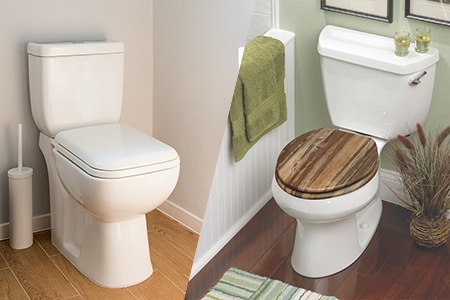
Let's go ahead and say upfront that neither of these types of toilet seats is better or worse and it will largely come down to your preference and what features you place the most importance or emphasis on.
Wood Seat – Pros
- They provide a stable surface temperature year-round
- You get a stylish, traditional look that's great for the home
- Wood is more durable & lasts longer than plastic or enamel-coated seats
Wood Seat – Cons
- They might rot if you don't give them the correct maintenance & care
- They aren't as efficient at shedding moisture
- Wood is harder to clean than plastic
Plastic Seat – Pros
- Easy to maintain & waterproof
- Long service lifespan
- Easy to clean & maintain
- Soft closing functionality
Plastic Seat – Cons
- Less aesthetic for the home
- It may distort in shape
- Less effective at retaining heat
- Tend to stain & crack more easily
In the next section, let's compare a plastic toilet seat with a wood veneer toilet seat. Then we'll do the same with a wood enameled toilet seat. Please note that they are different slightly. Also consider if you need a round or elongated seat, as toilet seats aren't universal.
The veneer option has a nicer laminate of wood on the outer surface while using cheaper materials on the inside. The enameled wood seats have a solid build but will be painted on the exterior, which results in a more sealed seat that's easier to maintain.
Plastic vs. Wood Veneer Toilet Seats
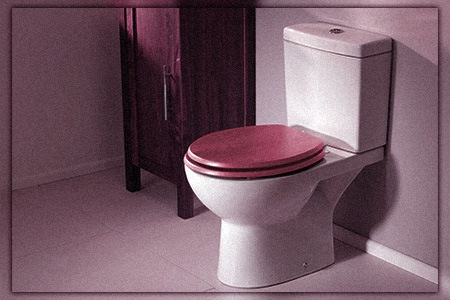
There are two types of wood seats for your toilet. You have options for wood veneer and enameled wood toilet seats. The enameled wood options usually feature a chipboard core because it's the cheapest wood, and you can't tell the difference after they're coated.
These seats look like they're plastic and sturdier than conventional plastic seats you see in public bathrooms. You also have the option for wood veneer seats. They feature construction with wood strips formed around a wooden core, displaying the wood's natural grain.
Styling & Comfort
Wooden toilet seats have a warm, inviting feel. They're a good choice for homes where you want a more rustic or traditional look to the bathroom. They blend in well with brass and darker-colored fittings and fixtures and bathrooms with hardwood floors or walls. Of course how well it meshes will depend on the types of toilets you have installed, too.
Plastic toilet seats have a less eye-pleasing aesthetic. They're sturdier than wooden seats and may shift around if a heavy person sits on them. Some plastic seats may distort their shape and crack over time. These seats are better for offices and public spaces, not homes.
Plastic seats don't have the same warmth as wooden seats. If you sit on a plastic seat in winter, it's cold and unforgiving. Wood veneer seats don't retain the cold, and they feel warmer. For the right bathroom decor, when it comes to a wood or plastic toilet seat, wood wins here.
Surface Hygiene
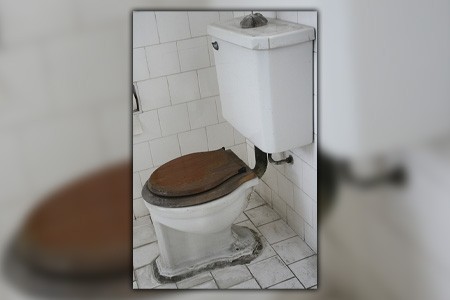
Wood veneer seats are harder to clean than plastic seats. Wood is porous, making it easier for bacteria to settle and stick to the surface. As a result, they require more maintenance and cleaning than plastic seats.
Older wood seats may see slight separation in the veneer, resulting in urine trapping in the seat, creating a smell in t bathroom. Plastic is non-porous and won't allow the permeation of bacteria and urine. In terms of a plastic or wood toilet seat, plastic wins here without a doubt, especially over time.
Versatility
Plastic seats are available in a wide variety of shapes and designs. Since it's easier to mold plastic than wood, you have more options for your seat styling. Plastic seats are also available in a soft-close, allowing you to avoid the seat making a loud banging noise if you accidentally drop it.
Wood seats are heavier and come in fewer designs. You get options for lighter and darker woods, but that's about it. They also don't feature a soft close, which might be annoying for your partner when you accidentally bang the lid in the en-suite bathroom in the middle of the night.
Durability
Wood seats are durable but aren't as infallible as you think. They tend to warp and crack if exposed to high temperatures or regular changes in humidity and temperature. However, the additional weight in the seat means they come with metal hinges, which are usually more durable than the components on plastic seats.
Plastic is also prone to cracking and distortion, but they typically last longer than wooden veneer seats. If you have to replace a toilet seat in a bathroom that gets steamy often, it might be better to go with a plastic seat.
Pricing
Wood veneer seats are much more expensive than plastic seats. They can be three or four times the cost. Wood is a more expensive material than plastic, and the manufacturing process is more extensive. If you're installing them at the office, a plastic seat reduces the company's expenses.
Plastic vs. Wood Enameled Toilet Seats
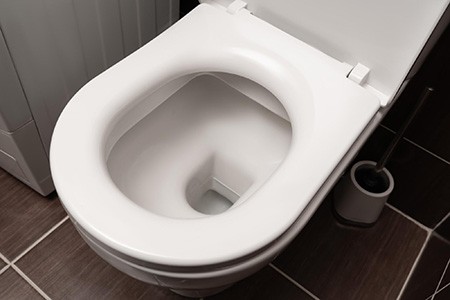
The enameled wood toilet seat is more affordable and durable than the veneered model. It blends the best features of plastic and wooden toilet seats into a hybrid model ideal for home or office bathrooms. You get the sturdy design of the wooden seat, with the durability of plastic. Let's compare plastic and enamel wooden seats.
Styling & Comfort
The enameled wooden toilet seat has better styling than the plastic toilet seat. You get a look similar to the thickness and weight of the wooden veneer seat while retaining the sleek, color-matched style of the plastic toilet seat. Enameled seats come in a range of colors to match your bathroom aesthetic.
Enameled seats might not have the same heat retention properties as the veneered model, but they're warmer than the plastic seat. They are thicker and heavier than plastic seats, giving them a more premium feel and look than plastic models.
Surface Hygiene
The enameled finish on the enamel wooden seat gives the same smooth, non-porous finish as the plastic toilet seat. It's as easy to clean as the plastic seat and doesn't have the same porous surface that traps bacteria and urine as found in the wood veneer seat.
The enamel can wear and crack over the years, and it's possible to stain it if you don't clean it properly. The quality of the enamel coating plays the biggest role in the seat's durability and how soon the enamel cracks. The quality of the enamel doesn't differ in the wood vs. plastic toilet seat industries in general. It depends on the brand and model each time.
Weight

The enamel seat typically has a chipboard core. So, it's lighter than the wooden veneer seat but heavier than the plastic seat. If you compare the enamel and wooden versions at a store, the weight difference is considerable.
The additional weight gives the enamel seat a similar premium feel as the wood veneer seat, and it has more thickness than the plastic seat. However, like the wooden veneer model, the enamel eats weight means it has the potential for loud slams when closing. Their added weight contributes nothing substantial to the overall weight of the toilet at large and is worth the premium feel.
Versatility
The wood enamel seat offers you the same versatility as the plastic seat. You get a wide variety of sizes and shape for the toilet seat, and some models come with a soft-close option, eliminating the weight causing the slamming problem when closing it.
Durability
The wood enamel seat is far more durable than the wood veneer seat and has better durability than the plastic seat. The enamel coating ensures the toilet seat doesn't warp or crack. It's also more resilient to scratching.
The wood enamel seat also features the same metal hardware as the wood veneer seat. In fact, most enamel seats will outlast the plastic and wood veneer models, and the hardware usually breaks before the toilet seat delaminates or cracks.
Pricing
Wood enamel seats are the mid-range price option of the three models. They're more expensive than plastic seats but more affordable than wood veneer seats. The price of the wood enamel version varies, depending on the manufacturing quality, the hardware, and if it has a soft-close feature.
FAQ's Concerning a Wooden or Plastic Toilet Seat
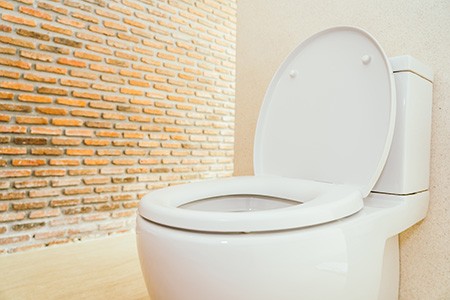
Here's a small collection of commonly asked questions that arise any time the topic of toilet seat material options comes up.
Will a Plastic Toilet Seat Stain?
Plastic toilet seats can get urine stains if they aren't cleaned regularly. However, you should be fine if you have a regular cleaning schedule. Some plastic toilet seats in public toilets may get yellow when they get very old.
Is a Wooden Veneer Toilet Seat Sanitary?
A wood veneer seat comes treated for humidity resistance. However, it loses this coating over time through regular use. Eventually, the toilet seat will crack or start to rot, especially in high-humidity bathrooms with showers.
Plastic or Wood Toilet Seat? The Choice is Yours!
So, which seat is the better choice for your home or office? If you're looking for a toilet seat for the office, we recommend using a plastic option. You get a functional toilet seat that costs half the wooden versions.
However, if you're a homeowner, we recommend using the wood veneer or wooden enamel option. If you want a more durable seat that matches your bathroom color, go with the wood enamel option. If you like a more traditional and rustic look, go with the wood veneer.
The wood veneer is the better choice for bathrooms featuring earthy or warm colors in the design aesthetic. You'll also have to consider the cleaning and the local climate. There are better choices than wood veneer seats for fitting bathrooms with showers where the humidity might cause the wood to expand and crack. So, a plastic or wood toilet seat? You now know how to make the decision. Go forth and decide!



